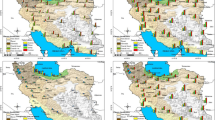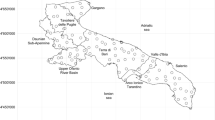Abstract
Drought and wetness events were studied in the Northeast Algeria with SPI and RDI. The study area includes a variety of climatic conditions, ranging from humid in the North, close to the Mediterranean Sea, to arid in the South, near the Sahara Desert. SPI only uses precipitation data while RDI uses a ratio between precipitation and potential evapotranspiration (PET). The latter was computed with the Thornthwaite equation, thus using temperature data only. Monthly precipitation data were obtained from 123 rainfall stations and monthly temperature data were obtained from CFSR reanalysis gridded temperature data. Both data sets cover the period 1979–80 to 2013–14. Using ordinary kriging, the gridded temperature data was interpolated to all the locations having precipitation data, thus providing to compute SPI and RDI with the same observed rainfall data for the 3-, 6- and 12-month time scales. SPI and RDI were therefore compared at station level and results and have shown that both indices revealed more sensitive to drought when applied in the semi-arid and arid zones. Differently, more wetness events were detected by RDI in the more humid locations. Comparing both indices, they show a coherent and similar behavior, however RDI shows smaller differences among climate zones and time-scales, which is an advantage relative to the SPI and is likely due to including PET in RDI.




Similar content being viewed by others
References
Akhtari R, Morid S, Mahdian MH, Smakhtin V (2009) Assessment of areal interpolation methods for spatial analysis of SPI and EDI drought indices. Int J Climatol 29:135–145
Allen RG, Pereira LS, Raes D, Smith M (1998). Crop evapotranspiration. Guidelines for Computing Crop Water Requirements. FAO Irrig. Drain. Pap. 56, FAO, Rome, 300 p
Banimahd SA, Khalili D (2013) Factors influencing Markov chains predictability characteristics utilizing SPI, RDI, EDI and SPEI drought indices in different climatic zones. Water Resour Manag 27:3911–3928
Bordi I, Fraedrich K, Gerstengarbe FW, Werner PC, Sutera A (2004) Potential predictability of dry and wet periods: Sicily and Elbe-Basin (Germany). Theor Appl Climatol 77:125–138
Bordi I, Fraedrich K, Sutera A (2009) Observed drought and wetness trends in Europe: an update. Hydrol Earth Syst Sci 13:1519–1530
Dile YT, Srinivasan R (2014) Evaluation of CFSR climate data for hydrologic prediction in data-scarce watersheds: an application in the Blue Nile River Basin. J Am Water Resour Assoc 50:1226–1241
Fuka DR, Walter MT, MacAlister C, Degaetano AT, Steenhuis TS, Easton ZM (2014) Using the climate forecast system reanalysis as weather input data for watershed. Hydrol Process 28:5613–5623
Giorgi F, Lionello P (2008) Climate change projections for the Mediterranean region. Glob Planet Chang 63:90–104
Guttman NB (1999) Accepting the standardized precipitation index: a calculation algorithm. J Am Water Resour Assoc 35(2):311–322
Hamlaoui-Moulai L, Mesbah M, Souag-Gamane D, Medjerab A (2013) Detecting hydro-climatic change using spatiotemporal analysis of rainfall time series in Western Algeria. Nat Hazards 65:1293–1311
Hoerling M, Eischeid J, Perlwitz J, Quan X, Zhang T, Pegion P (2012) On the increased frequency of Mediterranean drought. J Clim 25:2146–2161
Karl TR, Williams CN Jr (1987) An approach to adjusting climatological time series for discontinuous inhomogeneities. J Climate Appl Meteor 26:1744–1763
Keyantash J, Dracup JA (2002) The quantification of drought: an evaluation of drought indices. Bul. Am Meteorol Soc 83:1167–1180
Khalili D,·Farnoud T, Jamshidi H,·Kamgar-Haghighi AA,·Zand-Parsa S (2011) Comparability analyses of the SPI and RDI meteorological drought indices in different climatic zones. Water Resour Manag 25:1737–1757
Kottek M, Grieser J, Beck C, Rudolf B, Rubel F (2006) World map of the Köppen-Geiger climate classification updated. Meteorol Z 15:259–263
Laborde JP, Mouhous N (2006). Hydrolab - Ajustements, Régressions, ACP, Variographie, … Université de Nice, Sophia Antipolis. (https://hydrologie.org/MOD/Hydrolab/hydrolab.htm)
McKee TB, Doesken NJ, Kleist J (1993) The relationship of drought frequency and duration to time scales. In: 8th Conf. Applied Climatology, Am Meteorol Soc, Boston, pp. 179–184
Meddi M, Assani A, Meddi H (2010) Temporal variability of annual rainfall in the Macta and Tafna catchments, northwestern Algeria. Water Resour Manag 24:3817–3833
Meddi M, Meddi H, Toumi S, Mehaiguen M (2013) Regionalization of rainfall in north-western Algeria. Geographia Technica 1:56–69
Merabti A, Martins DS, Meddi M, Pereira LS (2017) Spatial and time variability of drought based on SPI and RDI with various time scales. Water Resour Manage (this issue). https://doi.org/10.1007/s11269-017-1856-6
Mishra AK, Singh VP (2010) A review of drought concepts. J Hydrol 391:202–216
Mohammed R, Scholz M (2017) Impact of evapotranspiration formulations at various elevations on the reconnaissance drought index. Water Resour Manag 31:531–548
Moreira EE, Coelho CA, Paulo AA, Pereira LS, Mexia JT (2008) SPI-based drought category prediction using loglinear models. J Hydrol 354:116–130
Moreira EE, Pires CL, Pereira LS (2016) SPI drought class predictions driven by the North Atlantic Oscillation index using log-linear modeling. Water 8:43. https://doi.org/10.3390/w8020043
Mosaedi A, Abyaneh HZ, Sough MG, Samadi SZ (2015) Quantifying changes in reconnaissance drought index using equiprobability transformation function. Water Resour Manag 29:2451–2469
Nicault A, Alleaume S, Brewer S, Carrer M, Nola P, Guiot J (2008) Mediterranean drought fluctuation during the last 500 years based on tree-ring data. Clim Dyn 31:227–245
Palmer WC (1965) Meteorological drought, research paper 45, U.S. Department of Commerce Weather Bureau, Washington, D.C.
Paulo AA, Pereira LS (2007) Prediction of SPI drought class transitions using Markov chains. Water Resour Manag 21:1813–1827
Paulo AA, Martins D, Pereira LS (2016) Influence of precipitation changes on the SPI and related drought severity. An analysis using long-term data series. Water Resour Manag 30:5737–5757
Paulo AA, Pereira LS (2006) Drought concepts and characterization: comparing drought indices applied at local and regional scales. Water Int 31:37–49
Pereira LS, Cordery I, Iacovides I (2009) Coping with water scarcity. Addressing the challenges. Springer, Dordrecht, p 382
Saadi S, Todorovic M, Tanasijevic L, Pereira LS, Pizzigalli C, Lionello P (2015) Climate change and Mediterranean agriculture: impacts on winter wheat and tomato crop evapotranspiration, irrigation requirements and yield. Agric Water Manag 147:103–115
Saha S, Moorthi S, Pan HL, Wu X, Wang J, Nadiga S, Tripp P, Kistler R, Woollen J, Behringer D, Liu H (2010) The NCEP climate forecast system reanalysis. B Am Meteorol Soc 91:1015–1057
Shokoohi A, Morovati R (2015) Basinwide comparison of RDI and SPI within an IWRM framework. Water Resour Manag 29:2011–2026
Sousa PM, Trigo RM, Aizpurua P, Nieto R, Gimeno L, Garcia-Herrera R (2011) Trends and extremes of drought indices throughout the 20th century in the Mediterranean. Nat Hazards Earth Syst Sci 11:33–51
Spinoni J, Naumann G, Carrao H, Barbosa P, Vogt J (2014) World drought frequency, duration, and severity for 1951–2010. Int J Climatol 34:2792–2804
Surendran U, Kumar V, Ramasubramoniam S, Raja P (2017) Development of drought indices for semi-arid region using drought indices calculator (DrinC) – a case study from Madurai District, a semi-arid region in India. Water Resour Manag. https://doi.org/10.1007/s11269-017-1687-5
Taibi S, Meddi M, Mahé G, Assani A (2017) Relationships between atmospheric circulation indices and rainfall in Northern Algeria and comparison of observed and RCM-generated rainfall. Theor Appl Climatol 127:241–257
Tanasijevic L, Todorovic M, Pizzigalli C, Lionello P, Pereira LS (2014) Impacts of climate change on olive crop evapotranspiration and irrigation requirements in the Mediterranean region. Agric Water Manag 144:54–68
Thornthwaite CW (1948) An approach toward a rational classification of climate. Geogr Rev 38(55):94
Tigkas D, Vangelis H, Tsakiris G (2012) Drought and climatic change impact on streamflow in small watersheds. Sci Total Environ 440:33–41
Tigkas D, Vangelis H, Tsakiris G (2015) DrinC: a software for drought analysis based on drought indices. Earth Sci Inf 8:697–709
Touchan R, Anchukaitis KJ, Meko DM, Attalah S, Baisan C, Aloui A (2008) Long term context for recent drought in northwestern Africa. Geophys Res Lett 35:L13705. https://doi.org/10.1029/2008GL034264
Touchan R, Anchukaitis KJ, Meko DM, Sabir M, Attalah S, Aloui A (2011) Spatiotemporal drought variability in northwestern Africa over the last nine centuries. Clim Dyn 37:237–252
Tramblay Y, El Adlouni S, Servat E (2013) Trends and variability in extreme precipitation indices over Maghreb countries. Nat Hazards Earth Syst Sci 13:3235–3248
Tsakiris G (2017) Drought risk assessment and management. Water Resour Manag 31:3083–3095
Tsakiris G, Kordalis N, Tigkas D, Tsakiris V, Vangelis H (2016) Analysing drought severity and areal extent by 2D Archimedean Copulas. Water Resour Manag 30:5723–5735
Tsakiris G, Pangalou D, Vangelis H (2007) Regional drought assessment based on the reconnaissance drought index (RDI). Water Resour Manag 21:821–833
UNEP. 1997. World atlas of desertification. 2nd ed. United Nations Environment Programme, Arnold, London, 182 p
Vangelis H,·Spiliotis M,·Tsakiris G (2011) Drought severity assessment based on bivariate probability analysis. Water Resour Manag 25:357–371
Vangelis H, Tigkas D, Tsakiris G (2013) The effect of PET method on reconnaissance drought index (RDI) calculation. J Arid Environ 88:130–140
Vicente-Serrano SM, Begueria S, Lopez-Moreno JI (2010) A multiscalar drought index sensitive to global warming: the standardized precipitation evapotranspiration index. J Clim 23:1696–1718
Weiß M, Flörke M, Menzel L, Alcamo J (2007) Model-based scenarios of Mediterranean droughts. Adv Geosci 12:145–151
Worqlul AW, Yen H, Collick AS, Tilahun SA, Langan S, Steenhuis TS (2017) Evaluation of CFSR, TMPA 3B42 and ground-based rainfall data as input for hydrological models, in data scarce regions: the upper Blue Nile Basin, Ethiopia. Catena 152:242–251
Zarch MAA, Malekinezhad H, Mobin MH, Dastorani MT, Kousari MR (2011) Drought monitoring by reconnaissance drought index (RDI) in Iran. Water Resour Manag 25:3485–3504
Zarch MAA, Sivakumar B, Sharma A (2015) Droughts in a warming climate: a global assessment of standardized precipitation index (SPI) and reconnaissance drought index (RDI). J Hydrol 526:183–195
Zarei AR, Moghimi MM, Mahmoudi MR (2016) Analysis of changes in spatial pattern of drought using RDI index in south of Iran. Water Resour Manag 30:3723–3743
Zargar A, Sadiq R, Naser B, Khan FI (2011) A review of drought indices. Environ Rev 19:333–349
Zeroual A, Assani AA, Meddi M (2017) Combined analysis of temperature and rainfall variability as they relate to climate indices in Northern Algeria over the 1972–2013 period. Hydrol Res 48:584–595
Zeroual A, Meddi M, Bensaad S (2013) The impact of climate change on river flow in arid and semi-arid rivers in Algeria. In: Climate and land-surface changes in hydrology, proceedings of H01, IAHS-IAPSO-IASPEI Assembly, vol 359. IAHS Publ, Gothenburg, pp 105–110
Acknowledgements
The authors wish to thank the National Agency of Water Resources for providing the data of rainfall stations. Authors acknowledge FCT for the PhD research grant SFRH/BD/92880/2013 attributed to the third author, and thank Dr. Ana Paulo and Dr. Paula Paredes for their comments and support. Authors also acknowledge funding of LEAF Research Unit by FCT through the contract UID/AGR/04129/2013.
Author information
Authors and Affiliations
Corresponding author
Rights and permissions
About this article
Cite this article
Merabti, A., Meddi, M., Martins, D.S. et al. Comparing SPI and RDI Applied at Local Scale as Influenced by Climate. Water Resour Manage 32, 1071–1085 (2018). https://doi.org/10.1007/s11269-017-1855-7
Received:
Accepted:
Published:
Issue Date:
DOI: https://doi.org/10.1007/s11269-017-1855-7




